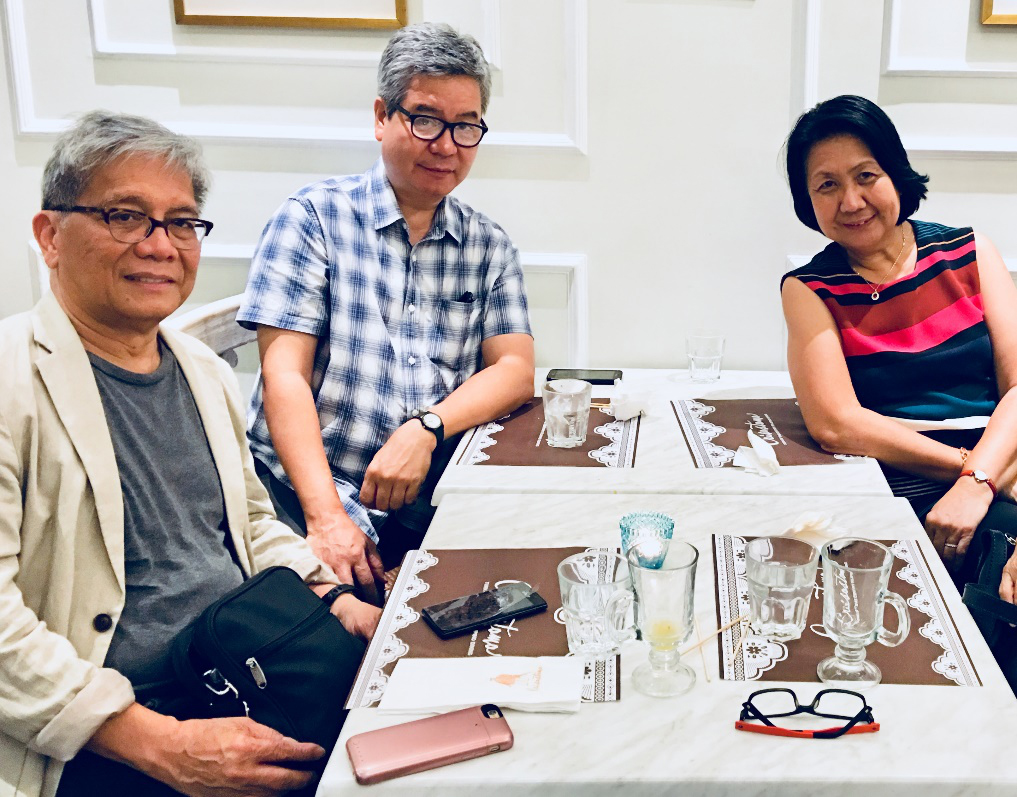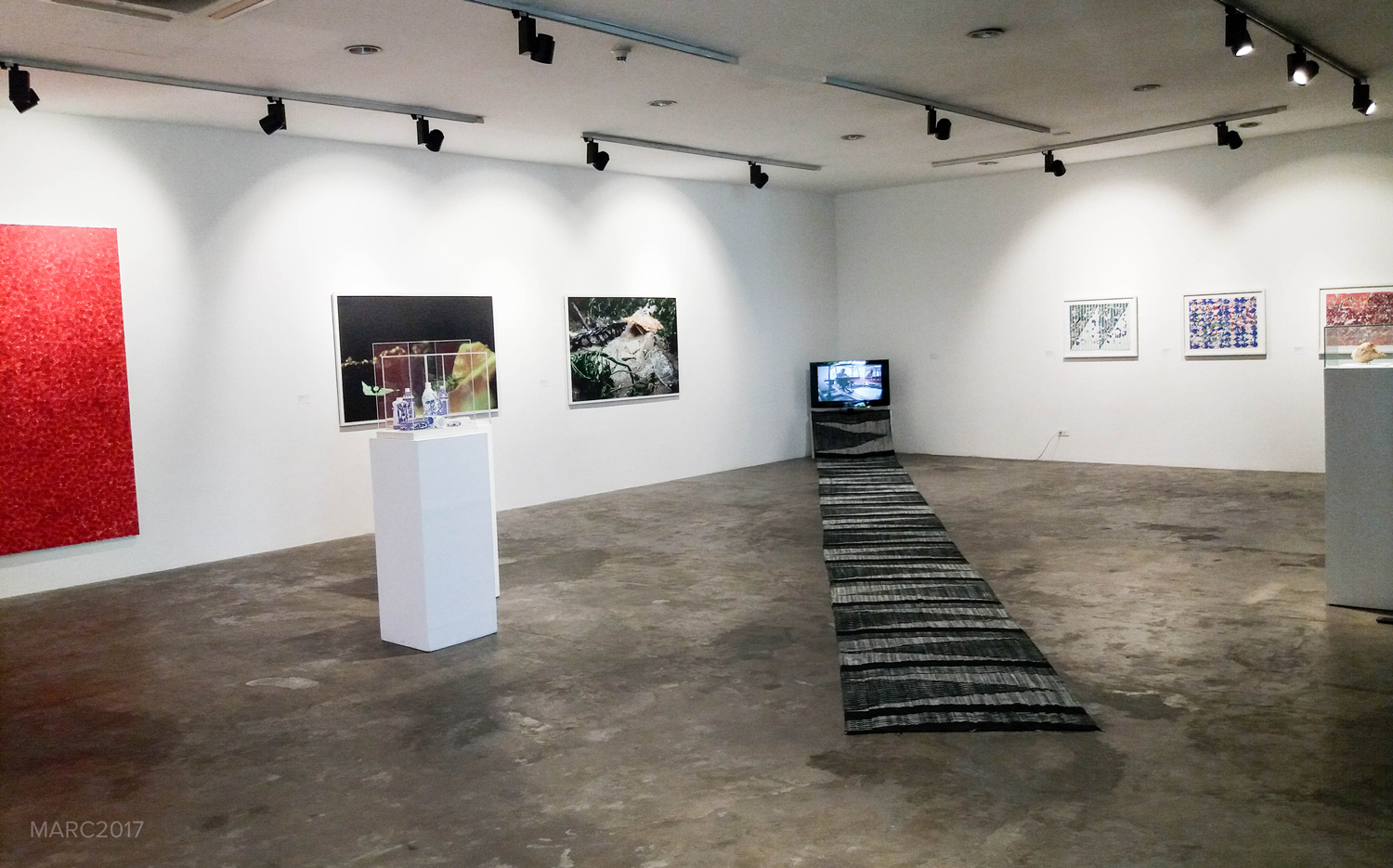Gerry Tan: Weaving Sound From a Tapestry
/That Gerry is a unique musician in his own right and although, he calls himself a sound artist, intrigued me, hoping that this encounter would be an outstanding culmination of my Fulbright research that coincidently started with Fe with a 10-day visit to the Kalinga province and a finale, several months later, at the edge of the U.P. Campus.
The setting was propitious as U.P. Center emerged out of the aging U.P. High Campus (where I graduated from as folks say, many harvests ago) into a first class shopping mall that Ayala has built on the leased land. Forward-thinking U.P. presidents from Dodong Nemenzo and Emer Roman to Fred Pascual have developed a leasing program of the properties around the main campus like the Tech Hub on Commonwealth Ave., the U.P. High on Katipunan Ave. and Ayala Tech Center on P. Garcia, to generate income and reduce the university’s dependence on the national budget that Congress plays political football with. The results have been salutary -- a surfeit of professional chairs, research grants, doctoral scholarships, and professional development funds. Leasing has become a source of university income that has kept its tuition one of the lowest in the country as it provides quality education. With it, U.P. can belong to the prominent list of elite universities, but without costing students an arm and a leg.
That said, as we enjoyed halo-halo at the Crisostomo Restaurant, named after the famed character in Jose Rizals’ novel, Noli Me Tangere. We reflected on the immense opportunities that artists, intellectuals, scholar/practitioners now can tap to enable their pursuits. Fe, now retired, has enough resources to continue collecting Indigenous People’s music whenever the opportunities arise, she being the ideal picture of an “audio hunter-gatherer.” During my field trip with her to Kalinga territory, the pickings were slim. But one afternoon, we got excited when we were invited to a wake in Tabuk. I went with high expectations, got my tape recorder ready, and entered a cluster of wood and cement block homes that now would shelter a Kalinga family unit. Quite a few of them have migrated from the rural villages to set up family domiciles with extended kin, here and there, in Tabuk City, a bustling provincial city in the Cordillera Administrative Region.
“Woven cloth is, process embodied, a living tapestry.”
It was already dark when we entered the compound, shining our smart-phone flashlight on the uneven footpath towards the home of the deceased. The men folk sat on benches outside, sharing beer and Coke drinks; the women were milling about a lit casket. As soon as we were seated, as is customary in Kalinga homes, coffee was offered. It must have been my fifth cup of the day. The younger women, students perhaps, were passing around sheets of paper-- I gathered song sheets. On signal, a slow uptake of the hymn “Amazing Grace” reached my senses. Soundwise, I was disappointed, half- expecting a more indigenous tune to be sung. My brain made a quick correction and checked my own cultural bias, recollecting my late evening chats with William “Scotty” Henry Scott in our Diliman home during my student days. Much of the Cordilleras have converted, as he described, if not to Catholicism, to either the Anglican or Episcopalian denomination. Scotty himself was a pastor of the latter.
As we prepared to return to Manila, Fe got a tip that she could record some songs from a former source, who was in the foothills of Tabuk City. We hurried over to the area, a one-hour road trip, to visit the home of her informant’s grandmother.
Their home was a larger wood and cement block construction with a basement and two or three rooms. I learned that Fe used to stay with them when she was researching in the area. After a round of the customary coffee during which we found out that the singer had gone on a trip elsewhere, we went to the grandmother’s room where she had been bedridden for a while now and was in danger of a serious and crippling asthma attack. Her rescue inhaler was already depleted. Asthmatic myself, I deeply empathized with her and could imagine the panic of not having the last puff to relieve the shortness of breath. I dug my hand into my fanny pack and felt, to my great relief, a spare inhaler that I always kept on road trips and handed it to the grandmother. Immediately, I could see her shoulders drop and relax in relief. It was my last inhaler, but I felt healthy and wouldn’t be long before I arrived in Manila to get a new prescription. It would otherwise be months before Grandmother would get hers. Music brings together odd fellows and incidents it seemed, as I recounted our adventures to Gerry. But for now he won’t get the recording that Fe hoped could be added to his repertoire of sounds.
Gerardo del Mundo Tan has shown his work in San Francisco. Based in Manila, he has an MFA from U.P. and SUNY-Buffalo, and is a fellow Fulbrighter. Trained as a visual artist who has exhibited in Manila and overseas, his turn to sound and its aesthetics adds a complex layer of thought to his earlier concerns about authenticity and cultural representation. Equally complex is how he addresses this question by combining sound and weaving, thus adding tangible texture to sound.
Gerry explained what his sound art is all about. What if, Gerry explained, instead of textile that weavers produced, the process is reversed and you use weaving sounds to design the textile. Furthermore, can it be interactive so that the weaver listens to the sound and recreates the sound into a woven design? The proposition sounded intriguing. I always thought that weavers employed a mnemonic strategy to memorize their intricate designs. It could be their music of rhythmic chants and beats for one, or, as Apo Onang answered the same question during our recent Kalinga trip, how she reminds herself from the intricate designs tattooed on her arms.
Apo Onang using with a backstrap loom. She learned weaving from her mother. The younger women no longer weave.
Apo Onang’s arms are tattoo with intricate designs.
Unfortunately, I could not stay long enough to experience Gerry’s installation that happened a few months later. However, I was able to ask a friend to review the event, printed here with little revisions.
Meeko Angela Camba is a student of journalism at U.P. with whom I became acquainted when she joined our NVM Gonzalez Writers’ Workshop a year before. We kept in touch and she had become curious of my research on textiles, an interest that I also shared with her mother. A practiced arts reviewer, here is what she thought of Gerry’s work:
“Rendering: The process behind the patterns, Mo Space Gallery, Bonifacio Global City. Meeko Angela Camba | Sept. 26, 2017
“For most people, the notion of indigenous textiles invokes one image: neatly woven designs in bright colors that allude to nothing more than a merchandize sold in an ever-growing market for local products.
“Rarely do buyers see how each hand-woven pattern contains much more than just yarn, but the story of hard work of an entire community.
“Artist Gerry Tan addresses exactly this.
“His mixed-media work, Rendering in the PROCESS/MEANING exhibit, urges people to look beyond the perfectly woven patterns known of indigenous textiles, and leads the audience, quite literally, to the laborious process behind it.
“In a collaboration with musicologist Felicidad Prudente, and traditional hablon weavers from a cooperative in Miag-ao, Iloilo, Tan made use of loom weaving sounds transcribed to musical notations, to produce new visual and textile forms.
Ikat work on exhibit with TV monitor
“The result, an Ikat cloth featuring what initially looked like a black and white zigzag pattern with each triangle separated by thick horizontal lines. The cloth, which was neatly spread across the floor, led to a video of a woman weaving behind her loom under a steady rhythm.
“It took quite some time to figure out how the two elements complemented one another. But looking at the work more closely, the zigzag pattern seemed to allude to sound waves that rose and fell across the textile; the horizontal lines served as bar lines that indicated pauses.
“In other words, it was the weaving process musically notated, then presented in the cloth itself. It held not only a pattern, but also a story of how people created them.
“The video was taken during Tan’s research work in 2016 with the Indag-an Primary Multipurpose Cooperative. The organization is composed of about 10 residents from Barangay Indag-an, an inland agricultural community in Iloilo, whose primary source of income was that earned from weaving, according to an article published in the News Today in 2008.
“The prices of their products are based on the kind, size and/or difficulty of the work, the article said. And with the way the system goes, it is just this numerical value, which customers use to judge the worth of such outputs—not the hard work, not the story.
“What makes Tan’s work interesting is how he bridges this gap by making the process the focus of the creation itself, at a much higher price than a textile’s normal value.
“For instance, there were no two cycles that were completely alike. Each one carried a different nuance in color, or by the way the lines curved and swayed, much like how no two textiles are completely the same. Behind each pattern is a different process—a different story of how it came to be.
“Though the pattern appeared to be smooth and clear-cut from afar, the lines were somewhat blurry compared to the usual designs of Ikat textile. While this might have been done unconsciously, it ultimately emphasized the difficulty of the weaving process; how the threads are hardly put together without much effort.”
Meeko is on point about Gerry’s work adding another level of sensual consciousness to the physicality of textiles. The work of the weaver, as I have discovered in my observations of them in Kalinga, Iloilo or Kalibo, is a design process that is all encompassing mentally and physically. There is the fiber/yarn to care for, the color to dye, the sensitivity to the yarn’s tautness that may affect the tightness of the weave, and so on; and yet to remember the thread counts and movement of the weft across the warp. It’s a way of thinking, a textile thinking that is mute to us. In a metaphorical way, Gerry is asking what if textile could speak-- here’s how it might sound. The process, from which the title of the exhibit comes, establishes the meaning of artistic work, something we may ascribe to the weavers, as a continuum of meaning. Sound, hands, color, and touch go far beyond the transitory pleasure of owning a piece of cloth. Woven cloth is, process embodied, a living tapestry.
Dr. Michael Gonzalez has degrees in History, Anthropology, and Education. A professor at City College San Francisco, he teaches a popular course on Philippine History Thru Film. He also directs the NVM Gonzalez Writers' Workshop in California. http://nvmgonzalez.org/writersworkshop/index.html
Meeko Angela Camba is a graduating journalism student at the University of the Philippines, Diliman, and a former intern at VERA Files. She is also the current president of the UP Journalism Club. She was the youngest participant in the NVM Gonzalez Writers' Workshop held in Mindoro and U.P. Diliman, 2016.
More articles from Dr. Michael Gonzalez








